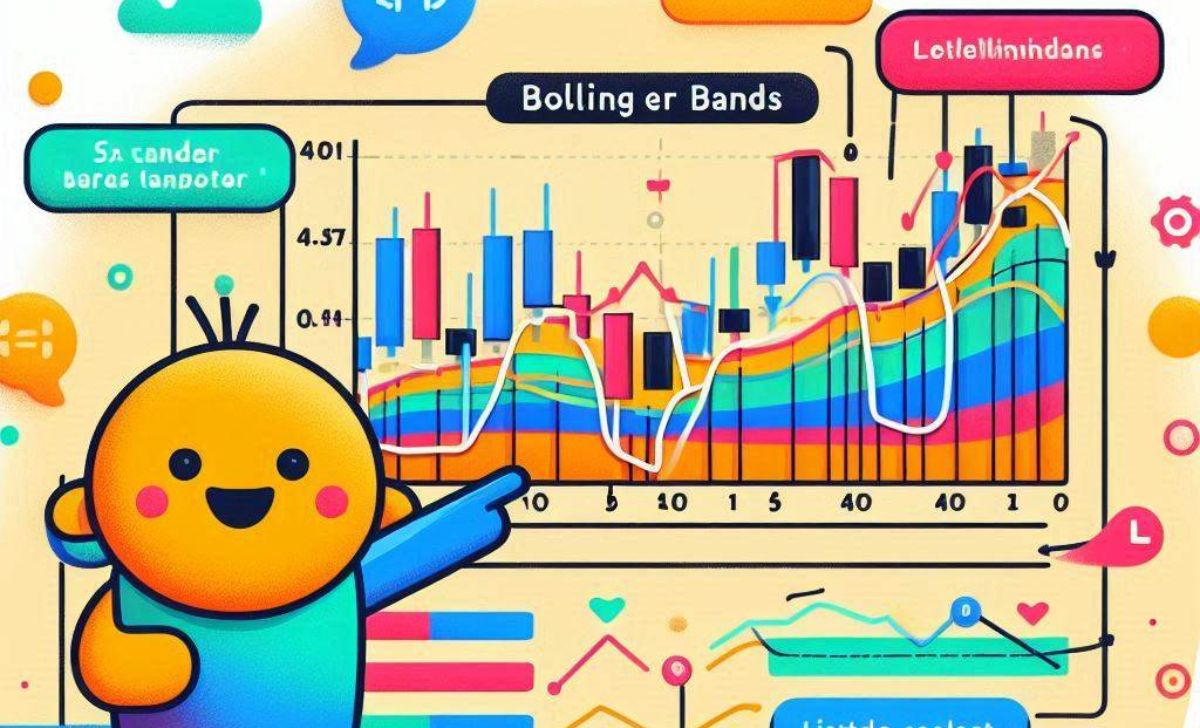Bollinger Bands play a key role in measuring market volatility and identifying potential price reversal points. By showing when prices are unusually high or low relative to recent averages, they help traders spot overbought or oversold conditions. This makes Bollinger Bands valuable for timing entries and exits, confirming trends, and detecting possible breakouts or consolidations in the market.
Bollinger Bands are a popular technical indicator used to measure market volatility and identify potential price reversals. On the XM platform, understanding how to use Bollinger Bands can help traders better gauge market conditions and make smarter trading decisions. In this article, we’ll explain how to apply Bollinger Bands for effective volatility analysis on XM.
What Is a Bollinger Bands Indicator?

Bollinger Bands are a volatility-based indicator that consists of three lines:
- A simple moving average (middle band)
- An upper band (SMA + 2 standard deviations)
- A lower band (SMA – 2 standard deviations)
Who Created Bollinger Bands and Why?
John Bollinger created this indicator to measure market volatility and detect relative highs and lows in price. It dynamically adjusts based on current price action.
What Are the Three Components?
Middle Band: Typically a 20-period simple moving average (SMA)
Upper Band: SMA + (2 × standard deviation)
Lower Band: SMA – (2 × standard deviation)
How Do Bollinger Bands Measure Volatility?
The width of the bands expands during high volatility and contracts during low volatility, providing visual cues about market conditions.
How Do Bollinger Bands Differ from Other Moving Averages?
While moving averages smooth price, Bollinger Bands add dynamic range via standard deviations, making them more responsive to volatility shifts.
Is Bollinger Bands a Reliable Indicator for Trading?

Bollinger Bands are a popular technical indicator used to analyze market volatility and identify potential trading opportunities. While they don’t predict the direction of price movement, they highlight zones where price may be overbought or oversold, increasing the likelihood of reversals. In trending markets, prices often move along the upper or lower bands, while in ranging markets, prices bounce between the bands, making them useful for both breakout and mean reversion strategies.
Why Bollinger Bands Are Widely Trusted by Traders
Bollinger Bands offer visual clarity and flexibility, making them beginner-friendly. However, when combined with other technical tools such as RSI, MACD, Fibonacci retracement, or volume indicators, they become powerful instruments for advanced traders as well. This adaptability across skill levels and market conditions contributes to their reliability.
Traders also appreciate that Bollinger Bands adjust dynamically based on market volatility, providing more accurate real-time signals compared to fixed-percentage indicators.
How Bollinger Bands Work and Their Core Strategies

Bollinger Bands are composed of three lines:
- Middle Band: A 20-period simple moving average (SMA)
- Upper Band: Two standard deviations above the SMA
- Lower Band: Two standard deviations below the SMA
These bands expand and contract with market volatility. A tight formation, known as the “Bollinger Band Squeeze,” signals that a breakout may be imminent.
Common Bollinger Band Trading Strategies
Bollinger Bands Breakout Strategy
- Look for a squeeze or narrow bands
- Enter when the price breaks above or below the bands
- Confirm breakout with volume spike, MACD, or recognizable chart patterns
Mean Reversion Strategy
- Buy when price hits the lower band during an uptrend
- Sell when price hits the upper band during a downtrend
- Use candlestick reversal patterns or RSI divergence for confirmation
Bollinger Bands + RSI
- Long entry: RSI below 30 + price touches lower band
- Short entry: RSI above 70 + price touches upper band
- RSI helps validate the overbought/oversold conditions
Bollinger Bands + MACD
- Buy: Price hits lower band + MACD bullish crossover
- Sell: Price hits upper band + MACD bearish crossover
- MACD confirms trend direction
How to Effectively Use Bollinger Bands in a Trading Plan

Using Bollinger Bands requires more than just understanding the indicator—you must incorporate them into a structured learn trading plan that includes entry, exit, and risk management.
Timeframe Selection
- Swing trading: Use H4 (4-hour) or Daily charts
- Intraday trading: Use M15 to M30 timeframes
- Scalping: Use 1-minute or 5-minute charts with tight settings
Setting Stop Loss and Take Profit
- Place stop-loss beyond the opposite band or recent swing high/low
- Target the middle band or key support/resistance areas
Backtesting and Optimization
- Use platforms like TradingView or MT5 for backtesting
- Test with 100+ trades to assess win rate, risk/reward ratio, and drawdown
- Stick with the default (20,2) setting unless testing supports adjustments:
- For high-volatility: (20, 2.5)
- For low-volatility: (20, 1.5)
Market Application
- Forex: Works well with EUR/USD, GBP/JPY, and other major pairs
- Stocks: Useful for breakouts and pullbacks in AAPL, TSLA, S&P 500
- Crypto: Effective with Bitcoin and high-volume altcoins; watch for false signals in low liquidity
Bollinger Bands vs. Other Technical Indicators

Understanding how Bollinger Bands compare to other volatility-based tools can help refine your strategy.
Bollinger Bands vs. Keltner Channels
- Bollinger Bands use standard deviation; Keltner Channels use Average True Range (ATR)
- Bollinger Bands are more sensitive to price spikes
Bollinger Bands vs. Moving Average Envelopes
- Envelopes use fixed percentage bands
- Bollinger Bands adjust dynamically with volatility
Bollinger Bands vs. Donchian Channels
- Donchian Channels reflect price highs/lows
- Bollinger Bands reflect volatility around the average price
Can Bollinger Bands Replace Other Tools?
Not entirely. They work best when combined with complementary indicators like RSI, MACD, or ATR. Each tool offers a different perspective on the market, and together they can improve your trading accuracy.
Common Mistakes to Avoid
- Misinterpreting a squeeze as a guaranteed breakout
- Ignoring volume when confirming breakouts
- Entering too early on band touches without confirmation
- Over-optimizing settings without robust backtesting
Enhancing Bollinger Bands with Other Tools
- Candlestick Patterns: Use doji, pin bar, or engulfing patterns with band touches
- Support and Resistance: Combine with horizontal levels for stronger signals
- Divergence: Use MACD or RSI divergence to validate reversals
- Volume Profile: Align high-volume nodes with squeeze zones
Bollinger Bands offer a robust framework for analyzing volatility, identifying breakout opportunities, and spotting overbought/oversold conditions. Whether you trade Forex, stocks, or crypto, this indicator can help uncover high-probability setups when used correctly.
To maximize their effectiveness:
- Combine them with other technical tools like RSI and MACD
- Always confirm signals and avoid over-reliance on a single indicator
- Stick to consistent backtesting and risk management
With discipline and proper application, Bollinger Bands can become a foundational element in your trading strategy.
Bollinger Bands remain one of the most versatile and insightful tools for traders seeking to understand market volatility, identify high-probability setups, and build effective trading strategies. While they don’t predict market direction, they offer valuable signals in both trending and ranging conditions—especially when used in combination with volume, RSI, MACD, or candlestick patterns. When using such tools on trading platforms, it’s important to stay informed about the platform’s Terms & Conditions, particularly regarding the use of indicators and data interpretation.
Whether you’re a beginner learning technical analysis or an experienced trader refining your edge, Bollinger Bands can enhance your decision-making and risk management. The key is consistent backtesting, aligning with market context, and avoiding common pitfalls like premature entries or over-optimization.
By integrating Bollinger Bands into a well-rounded trading system, and ensuring your strategies comply with relevant Terms & Conditions, you can better navigate Forex, stocks, or crypto markets with greater confidence and clarity.

Darius Elvon is a financial content strategist and editor with a strong focus on clarity and accuracy. He crafts easy-to-follow XM articles, covering promotions, trading tools, and platform updates to enhance user engagement. Email: [email protected]

 Tiếng Việt
Tiếng Việt